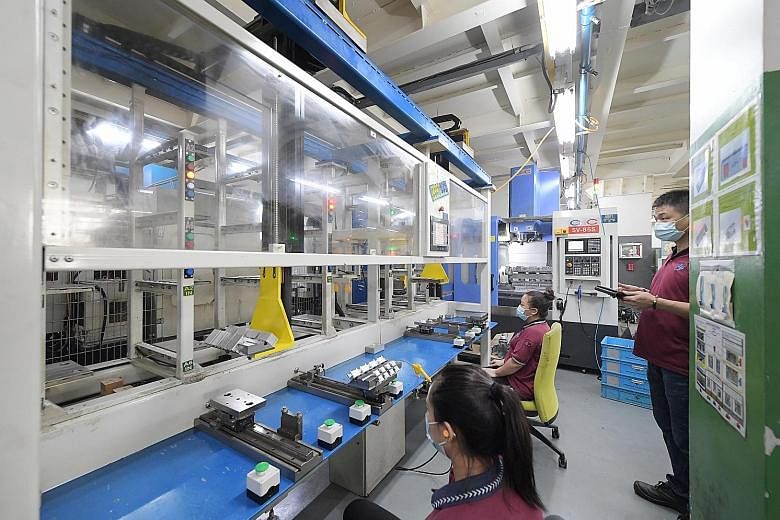Singapore's manufacturing output dropped for the first time in three months in October, with only the biomedical and precision engineering clusters seeing growth.
Factory output fell 0.9 per cent year on year, after a revised 25.6 per cent jump in September and a 16.4 per cent rise in August, according to data released yesterday by the Economic Development Board (EDB).
Economists had expected a 6.2 per cent increase, according to the median in a Reuters poll.
However, most analysts said the unexpected turn was unlikely to change the trajectory of the economic recovery.
They said that even the relatively slow start to the fourth quarter will eventually give way to stronger output next year, backed by rising global demand.
On a seasonally adjusted month-on-month basis, last month's output shrank 19 per cent - after four consecutive months of sequential improvement, and was the worst since February when it dropped by 22 per cent.
Transport engineering led the output decline with a 31.8 per cent year-on-year plunge.
EDB said in a statement yesterday that levels of activity in aerospace firms and shipyards remained low as new orders were adversely impacted by travel restrictions and a weak global oil and gas market.
General manufacturing contracted 12.8 per cent last month on a year-on-year basis, with all segments recording output declines.
The biomedical cluster grew 10.2 per cent year on year, cooling from the 91.2 per cent output surge it enjoyed in September.
Without this segment, overall manufacturing would have dropped by 2.7 per cent.
Precision engineering output also increased - by 10.6 per cent last month, compared with the same period a year ago.
Electronics output declined 0.6 per cent year on year last month, after pandemic-driven demand drove double-digit gains in the previous two months.
While the electronic modules and components as well as computer peripherals and data storage segments grew 16 per cent and 20.2 per cent respectively, the semiconductors as well as infocomms and consumer electronics segments shrank 2 per cent and 2.5 per cent respectively.
However, the electronics cluster's output is still up by 7.1 per cent year on year in the first 10 months of this year.
Ms Selena Ling, OCBC Bank's chief economist and head of treasury research and strategy, said the manufacturing data confirmed her earlier expectation of a fourth-quarter growth wobble after a V-shaped third-quarter bounce.
The possible soft patch in the fourth quarter was also flagged by the non-oil domestic exports data for last month, which showed a 3.1 per cent decline, snapping four straight months of growth.
Electronics shipments dipped 0.4 per cent after rising 21.4 per cent the previous month, figures released last week showed.
"The key question is whether the current soft patch in electronics, particularly semiconductors, will persist in the coming months," said Ms Ling, noting that so far, there does not appear to be any suggestions of widespread semiconductor industry weakness worldwide.
The semiconductors and electronics machinery industry is tipped to see 9.7 per cent growth this year, with a pickup into next year, according to Interact Analysis.
"This October soft patch certainly poses downside risk to Singapore's fourth-quarter manufacturing and GDP (gross domestic product) growth," said Ms Ling.
That said, the 2021 official GDP growth forecast of 4 per cent to 6 per cent assumes the overall recovery will sustain into next year, she noted.
Mr Sin Beng Ong, analyst at JP Morgan, said last month's manufacturing performance was more of a blip in the economic upswing.
"We view this as a pause rather than a change in trend," he said.
Singapore's October Purchasing Managers' Index (PMI) signalled expansion, consistent with the other regional surveys, he said.
"Moreover, the November flash PMIs from the developed markets convey a similar resilience in manufacturing despite the rise in Covid-19 cases," he noted.
The PMI data earlier this month showed that the manufacturing index inched up to 50.5 last month from 50.3 in September, moving slightly further above the 50-point threshold that separates expansion from contraction.


